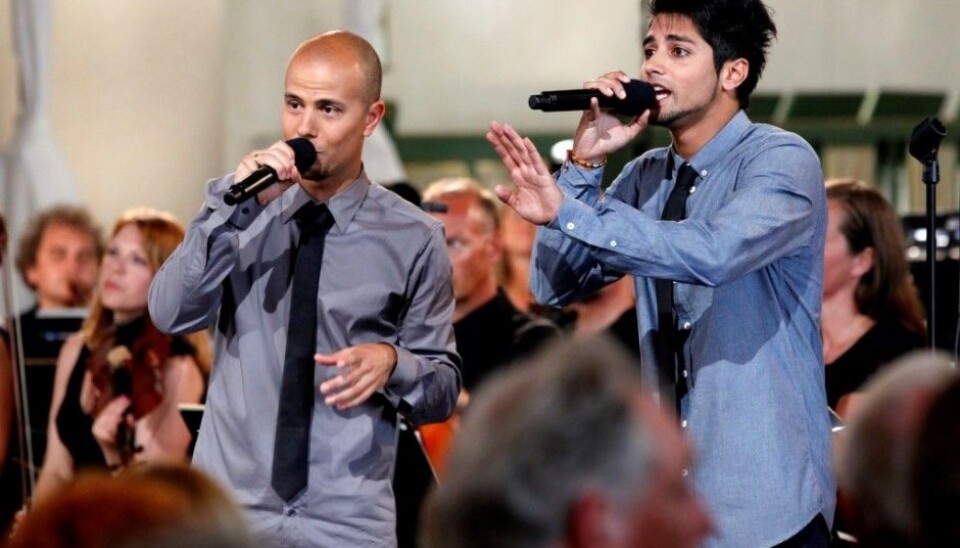
Rap music has found a place in Norwegian culture
Norwegian rap music is no longer a mere copy of the American genre, according to a researcher.
Denne artikkelen er over ti år gammel og kan inneholde utdatert informasjon.
To be a real rapper, there seems to be several requirements, such as a strong link to a particular place and a position on the fringe of mainstream society. In addition, the music tends to be characterized by macho stereotypes that glorify crime, materialism and sexism.
In Norway, rap has gradually become a well-established genre that sells well.
Birgitte Sandve, from the Department of Musicology at the University of Oslo, has investigated the rap artists Jesse Jones, Lars Vaular and Karpe Diem, analysing concerts, lyrics, music videos and how they are portrayed in the media.
She has found much to suggest that Norwegian rappers have made the American genre their own.
Local links
Sandve believes that one of the most important ideals in rap music is to “keep it real”, to be credible. Staying close to your home and background seems to be important.
The Norwegian artists use samples from other songs, placing the meaning in a new context while staing in touch with more familiar culture.
In one example, the track «Gategutt» (Street boy), Oslo rapper Jesse Jones used a sample from Lillebjørn Nilsen’s song with the same name.
“A kind of relationship across time and space is established when Jones portrays himself as a ‘criminal nigger’ while using Nilsen’s song is about a white street kid. This is an example of how ideas about identity and urbanity are connected musically,” according to Sandve.
Masculine stereotypes
Hip hop is dominated by a sometimes overly macho image, including stereotypical notions of violent, sexist men.
“This is a problematic aspect of the genre, but it’s also important to understand the social context of these ideas,” Sandve explains.
Hip hop culture originated in New York in the 70s, in neighbourhoods that were characterized by social deprivation, gang crime and racial discrimination. The music was used by minority youth to describe their experiences of oppression in American society, according to Sandve. This may have contributed to the macho image in rap music today.
“The hard masculinity found in much American rap music reflects the society and the conditions that the genre developed under. Some of these elements are carried over to the Norwegian variant, but many things have changed. It relates to a very different reality,” Sandve continues.
The Norwegian rapper Jesse Jones enacts this macho stereotype, but he tones down the sexism. Lars Vaular challenger the genre when he, in the music video Fett, makes out with the jetsetter Edna Falao, forty years his senior.
Image is important
The various elements that constitute the genre requirements of rap music may speak volumes about the artist’s identity. Views on gender, local identity and an outsider role tends to shape the artist.
“They create a persona, a link between the artist on stage, the person behind the scenes, and the various characters portrayed in songs and videos,” she says.
“So you can’t be rap artist without having seen some hard times?”
“Compared to the original rappers, these artists have it easy. But they still created an image of a person outside of the majority community,” says Sandve.
Norwegianness
It is clear that Norwegian rappers have found their way into Norwegian culture, although they remain close to American genre demands. When impulses from abroad are mixed with local ingredients, the result is a new perspective on being Norwegian.
Karpe Diem, who sometimes make a point of their mixed cultural and ethnic background, allows for reinterpretation of Norwegian identity. As an example, Sandve mentions the duo’s performance of “Byduer i dur” after the terror attacks 22 July 2011.
“When the group was selected for the performance during the first memorial service, the background from Oslo become part of the dialogue on national identity,” she says.
A spotlight
It is possible to track a societal frustration in Norwegian rap.
“Jesse Jones describes the reality of Norwegians of colour, growing up on the east side of Oslo. He puts words to ethnic stigmatization in society. Lars Vaular depicts male characters on the fringes of society.”
Since these artists have gained a place in mainstream culture, the outsiders are given a place in society, Sandve believes.
“It all goes to show that music provides a snapshot of society. Given that Norwegian rap music is a source of entertainment and identification for a growing audience, the ideas about identity and belonging needs to be taken seriously,” says Sandve.
----------
Read the Norwegian version of this article at forskning.no
Translated by: Lars Nygaard


































